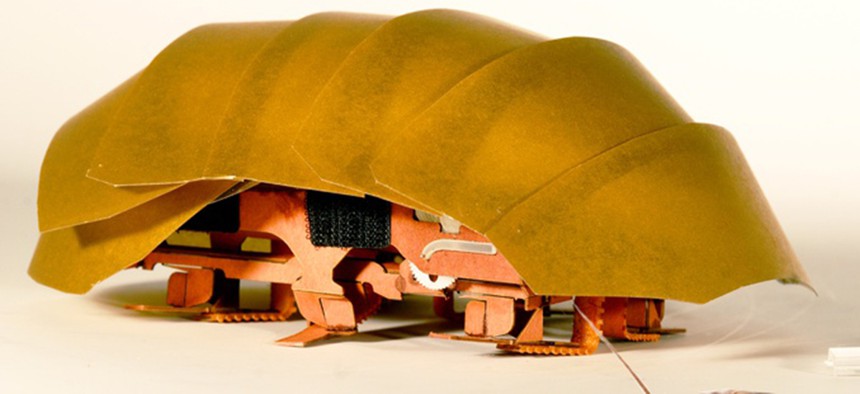The Army Has Made a Robot Cockroach

The CRAM robot coachroach from Berkley. Robert Full/Berkley
Biologically inspired robot bugs could be the next big thing in intelligence collection.
Researchers from Berkeley today announced the creation of a robot cockroach, called the compressible robot with articulated mechanisms, or CRAM, funded in part by the Army Research Laboratory under the Micro Autonomous System and Technology or MAST, program.
Why does the military need roboroaches? Put aside your feelings of revulsion toward periplaneta americana and consider for a moment the design miracle that is the American cockroach. Ever seen a cockroach scurry from the light into an incredibly tight crevice? The American cockroach is about stands 12.52 mm tall but can squeeze itself down to as small as 3 mm in height, about two stacked pennies, when it has to find cover. That shape change doesn’t even slow the bug down when it runs.
The Berkeley creation is larger, about palm-sized, but still possess this unique, shape-shifting trait.
“Like the animal, the robot successfully locomotes in vertically confined spaces by compressing its body in half (54%; 75–35 mm) and benefits from possessing a low friction shell,” the authors write in their paper, which appeared in the Proceedings of the National Academies of Science today. “We have been able to make our palm-sized, confined-space crawling robot completely autonomous in power and control, while weighing just 46 g including onboard electronics and battery.”
CRAM it isn’t the military’s first foray into robotic or semi-robotic insects. The robot fly funded by Defense Advanced Research Projects Agency, or DARPA, in the video below weighs just 60 milligrams and stands at 3 centimeters tall. But steering remains a real issue.
The military has also funded robo-insect projects of a more Frankensteinian flavor, attaching small computers to real bugs to create semi-robotic monsters. Back in 2006, DARPA announced a program to “develop technology to create insect cyborgs.” The program produced more than a few interesting breakthroughs. In the video below, researchers Hirotaka Sato, Michel Maharbiz and others demonstrate a system for steering a beetle via direct nerve and muscle stimulation.
The Berkeley team’s CRAM robot has clear applications in disaster response, in which it might carry a data collection device into the debris of a fallen building to hunt for survivors. But MAST isn’t just in the first-responder business. The $6.4 million program exists primarily to fund and develop autonomous (in this case, self-steering) robots for collecting intelligence and situational awareness in small spaces for soldiers.
The CRAM robot isn’t outfitted with cameras or live video feed to do roach reconnaissance, but Kaushik Jayaram, one of the paper’s lead authors, is reportedly working on that at Harvard.
NEXT STORY: Should We Fear an AI Arms Race?






